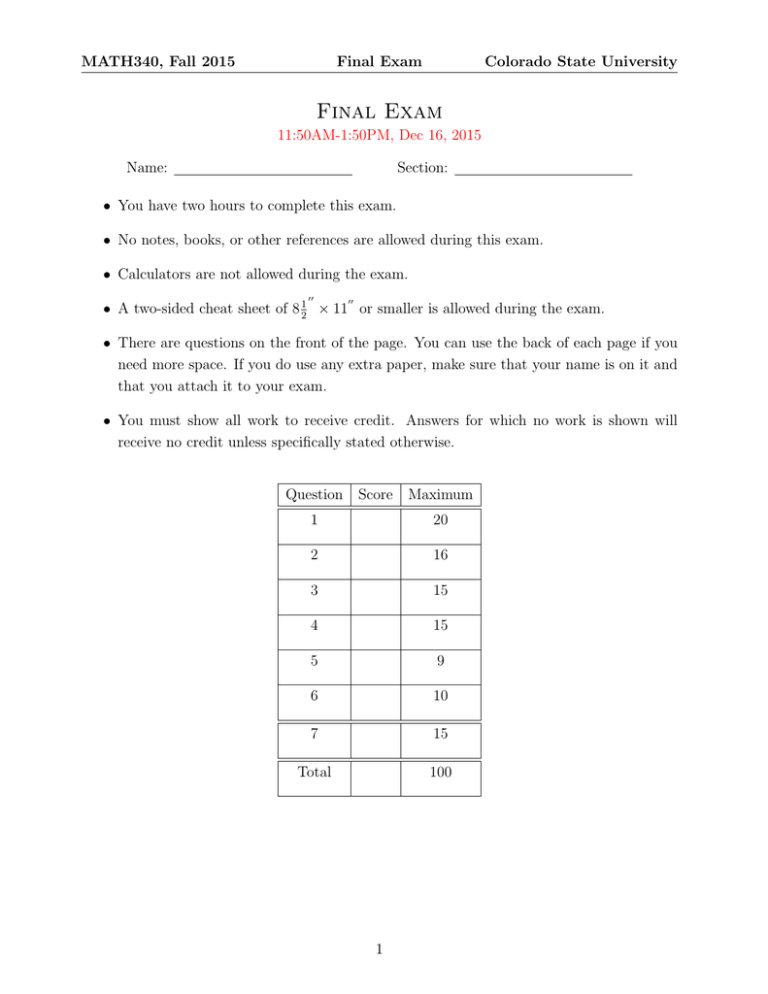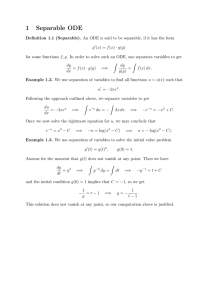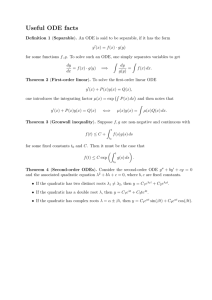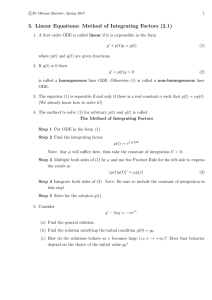Final Exam
advertisement

MATH340, Fall 2015 Final Exam Colorado State University Final Exam 11:50AM-1:50PM, Dec 16, 2015 Name: Section: • You have two hours to complete this exam. • No notes, books, or other references are allowed during this exam. • Calculators are not allowed during the exam. 00 00 • A two-sided cheat sheet of 8 21 × 11 or smaller is allowed during the exam. • There are questions on the front of the page. You can use the back of each page if you need more space. If you do use any extra paper, make sure that your name is on it and that you attach it to your exam. • You must show all work to receive credit. Answers for which no work is shown will receive no credit unless specifically stated otherwise. Question Score Maximum 1 20 2 16 3 15 4 15 5 9 6 10 7 15 Total 100 1 MATH340, Fall 2015 Final Exam Colorado State University 1. (20 points) Multiple-choice questions. There is one and only one right choice for each question. (i) Which statement below is FALSE? (a) Every exact first-order ODE is separable. (b) Every automonous first-order ODE is separable. (c) A first order linear ODE might also be separable. (d) A first order linear ODE might not be separable. (ii) What is a suitable integrating factor µ(t) for solving the following linear equation (1 − t2 )y 0 + 4y + t2 = 0, (a) µ(t) = (ln(1 − t2 ))−2 2 1+t (b) µ(t) = 1−t (c) µ(t) = e4t (d) µ(t) = e4 arctan(t) 2 −1 < t < 1? MATH340, Fall 2015 Final Exam Colorado State University (iii) Suppose y1 (t) = 3te−t and y2 (t) = (1 + t2 )e−t are both solutions of the second order linear ODE: y 00 + p(t)y 0 + q(t)y = 0. Which one of the statements (a) through (c) below is FALSE? Select (d) if statements (a) through (c) are all true. (a) y(t) = (1 + 6t + t2 )e−t is also a solution. (b) y(t) = 0 is also a solution. (c) y1 (t) and y2 (t) form a set of fundamental solutions. (d) All three statements above are true. (iv) Which equation below has the property that all of its solutions tend to zero as t → ∞? (a) y 00 + 6y 0 + 9y = 0. (b) y 00 − 4y 0 − 5y = 0. (c) y 00 − 4y 0 + 5y = 0. (d) y 00 + 25y = 0. 3 MATH340, Fall 2015 Final Exam Colorado State University 2. (16 points) Below we have four linear systems. Matching each system with the corresponding figures of the phase plane (A,B,C, or D) and the plots of the general solutions x(t), y(t) (I, II, III, or IV). Also, draw arrows on the trajectories in each phase plane to denote the correct directions of these trajectories for the corresponding linear system. Linear ODE system x0 = −x + y, General solution plot y 0 = −x − y x0 = −x, y 0 = −2y x0 = −y, y0 = x x0 = x, Phase plane y 0 = 2y (A) (B) (C) (D) (I) (II) (III) (IV) 4 MATH340, Fall 2015 Final Exam Colorado State University " 3. (15 points) Consider a linear system x0 = Ax with A = 4 −10 2 −4 # . (i) Find the complex eigenvalues and eigenvectors of the matrix A. (ii) Find the complex general solution of this system. (iii) Does there exist a fundamental set of real solutions for this 2 × 2 system regardless of its complex eigenvalues and eigenvectors? Why? Find the fundamental set of real solutions for the above system if it exists. 5 MATH340, Fall 2015 Final Exam Colorado State University 4. (15 points) Consider the linear system x0 = Ax, where −1 −1 0 A = −1 0 −1 . −1 2 −2 (i) Recall that etA = eλtI+t(A−λI) = eλt et(A−λI) for any number λ. Now we know the matrix A has a single eigenvalue λ = −1. Calculate etA using this information. (ii) Find the general solution of the system x0 = Ax. 6 MATH340, Fall 2015 Final Exam Colorado State University 5. (9 points) Consider a second-order differential equation d2 x dx = 3x − x3 . + 2 2 dt dt (i) Convert this equation into a first-order system. (ii) Find all the equilibirum points of this second-order equation. 7 MATH340, Fall 2015 Final Exam Colorado State University 6. (10 points) Consider an ODE y 00 − 2y 0 + 5y = 3 cos t. (i) Use the method of undetermined coefficients to find one particular solution; (ii) Find the general solution. 8 MATH340, Fall 2015 Final Exam Colorado State University 7. (15 points) Use the method of Laplace transform to solve the initial value problem y 00 − 4y 0 − 5y = et − 1, 9 y(0) = 1, y 0 (0) = 1.



